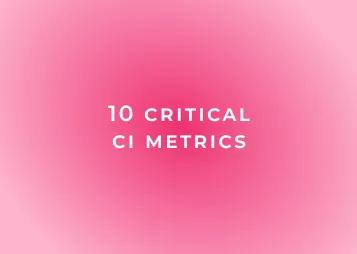The prospect handover from marketing to sales is where your leads are transformed into valuable opportunities. And the success of this process significantly impacts your overall sales performance.
Over my years of working in revenue, I’ve learned that to ensure a seamless and effective transition, it is essential to play by some golden rules. So if you're feeling friction at this crucial point in your sales pipeline or things are getting missed, try these out with your teams.
1. Clear definitions
A successful handover begins with a shared understanding of definitions - what qualifies as a marketing-qualified lead, a sales-accepted lead and an opportunity. Misalignment on these definitions only leads to confusion and inefficiency in your sales pipeline.
It’s key to set clear rules of engagement for everyone in both sales and marketing and to regularly educate around this as the market changes.
A lead is a prospect expressing interest in a product or service. But defining the specific actions or behaviors that signify a lead specific to your business will prevent any ambiguity.
Equally, an opportunity is a qualified lead that has demonstrated a higher likelihood of conversion. But what does this look like in your market? Maybe an engagement with marketing materials, attending webinars, or other behavior suggesting a readiness to purchase.
By aligning these definitions, sales and marketing can work towards a common goal, so that only the most promising leads are handed over to the sales team. This streamlines the process and allows for more accurate targeting, saving time and resources.
Beyond your definitions, it’s good to have a shared understanding of the direction a lead will travel when they enter the pipeline. For example, if a meeting is booked but there is a no-show, everyone in the team should know the next action and who is responsible for taking it.
2. Watertight documentation
Lead information accuracy, in relation to your ICP, is worth its weight in gold. So as far as possible, marketing should seek to use tickboxes with your ICP criteria in the lead generation process.
Capturing this information and storing it in your CRM in a way that is useful to multiple teams is crucial. This includes not only basic contact details but also valuable insights into a lead's interactions with marketing content.
Setting clear best practices for the documentation and transfer of lead information prevents critical data from slipping through the cracks. Regularly reviewing and updating lead profiles ensures that sales teams have the information they need.
3. Speed to lead
Now don’t quote me on this, but I’m pretty sure the old adage ‘time is money’ was created by a RevOps Manager during a marketing to sales handover.
The quicker a lead is handed over from marketing to sales and progresses through into the pipeline, the greater the likelihood of conversion. So speed is of the essence when it comes to the transition of leads.
A quick and slick response from a sales team not only demonstrates attentiveness and professionalism but also capitalizes on the prospect's current level of interest. Strike while the iron is hot, and all that.
We use a meeting scheduler to get meetings booked as quickly as possible, operating in international markets. But automated lead routing systems can also play an important role in supporting this process by instantly directing leads to the appropriate sales representative based on predefined criteria.
Equally lead scoring, while it is never perfect, does allow you to prioritize leads if you are stretched on capacity, to make your process as efficient as possible.
4. Context in abundance
No two opportunities are created equal.
Understanding the context in which a lead has been generated is fundamental to tailoring the sales team’s approach. There is so much value in knowing as much about the lead and their journey as possible, such as:
- Lead source
- Opportunity size
- The website page they converted on
Different lead sources may require distinct approaches. A lead generated from a webinar might have different expectations and preferences compared to one that came in from a paid social campaign about a new feature. Similarly, knowing the size of the opportunity allows the sales team to allocate appropriate resources and customize their pitch to align with the lead's potential value.
Considering the lead's journey is equally critical. Awareness of the content they have interacted with and any previous communication ensures that the sales team can pick up the conversation seamlessly. This demonstrates a keen understanding of the lead's needs and enhances the overall customer experience.
By providing the sales team with this contextual information, the handover becomes more than just a transfer of data – it becomes a partnership, an alignment between marketing efforts and the potential customer's expectations.
5. Next level accountability
Accountability is the lynchpin that holds the entire marketing to sales handover together.
Assigning specific individuals to take ownership of lead follow-up is essential for maintaining a structured and efficient workflow.
Having a designated point of contact ensures there is no ambiguity regarding who is responsible for engaging with a lead once it enters the sales pipeline. This accountability encourages a sense of ownership and urgency, encouraging swift and purposeful action from each team member.
Establishing a feedback loop between marketing and sales will also support continuous improvement and optimization of your pipeline. Regular meetings or reviews can provide insights into the effectiveness of lead generation strategies, the quality of leads, and the success of the sales approach.
Our sales and marketing teams meet at least once a week to discuss the current pipeline and how leads are progressing. This collaborative feedback loop allows us to make iterative adjustments, ensuring that our handover process evolves in line with changing market dynamics and customer behaviors.
I’ve automated our new lead alerts to come through to our Slack channels, so there is no chance of any slipping through and not being followed up.
The marketing/sales handover is such a critical point in the new business acquisition process and a technique that should be refined and bespoke to every business. Next up is the Sales - Customer Success handover.
Lucky for you, we've shared our golden rules for this here.
Dan Wilson is the Head of Revenue Operations at Jiminny, implementing new strategies and procedures to improve efficiency, performance, and customer satisfaction across the sales cycle and beyond. With over eight years in operations and five years with revenue teams, Dan has managed and coached teams through numerous challenging situations. He is endlessly passionate about using data, insights and human interactions to drive business decisions and optimize business processes.





.webp)






